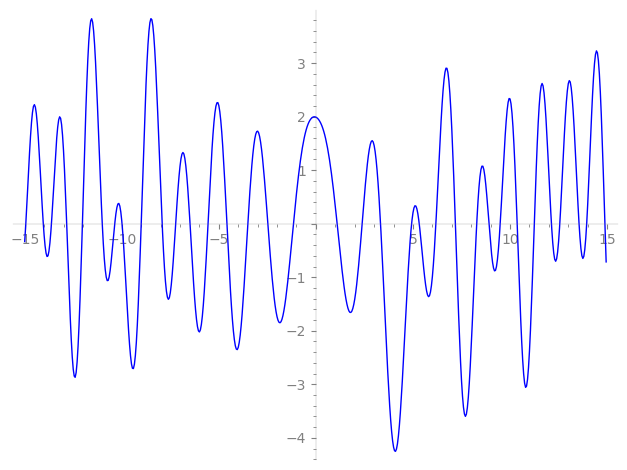| L(s) = 1 | + (1.70 + 1.44i)5-s + (0.308 − 2.62i)7-s + (−0.919 + 1.59i)11-s − 0.356i·13-s + (3.16 + 1.82i)17-s + (0.936 + 1.62i)19-s + (5.76 − 3.33i)23-s + (0.802 + 4.93i)25-s + 2.37·29-s + (3.37 − 5.84i)31-s + (4.33 − 4.02i)35-s + (−3.66 + 2.11i)37-s − 1.83·41-s + 2.80i·43-s + (7.63 − 4.40i)47-s + ⋯ |
| L(s) = 1 | + (0.761 + 0.647i)5-s + (0.116 − 0.993i)7-s + (−0.277 + 0.480i)11-s − 0.0988i·13-s + (0.768 + 0.443i)17-s + (0.214 + 0.372i)19-s + (1.20 − 0.694i)23-s + (0.160 + 0.987i)25-s + 0.440·29-s + (0.605 − 1.04i)31-s + (0.732 − 0.680i)35-s + (−0.602 + 0.347i)37-s − 0.287·41-s + 0.427i·43-s + (1.11 − 0.643i)47-s + ⋯ |
Λ(s)=(=(1260s/2ΓC(s)L(s)(0.986−0.161i)Λ(2−s)
Λ(s)=(=(1260s/2ΓC(s+1/2)L(s)(0.986−0.161i)Λ(1−s)
| Degree: |
2 |
| Conductor: |
1260
= 22⋅32⋅5⋅7
|
| Sign: |
0.986−0.161i
|
| Analytic conductor: |
10.0611 |
| Root analytic conductor: |
3.17193 |
| Motivic weight: |
1 |
| Rational: |
no |
| Arithmetic: |
yes |
| Character: |
χ1260(109,⋅)
|
| Primitive: |
yes
|
| Self-dual: |
no
|
| Analytic rank: |
0
|
| Selberg data: |
(2, 1260, ( :1/2), 0.986−0.161i)
|
Particular Values
| L(1) |
≈ |
1.990894007 |
| L(21) |
≈ |
1.990894007 |
| L(23) |
|
not available |
| L(1) |
|
not available |
L(s)=p∏Fp(p−s)−1 | p | Fp(T) |
|---|
| bad | 2 | 1 |
| 3 | 1 |
| 5 | 1+(−1.70−1.44i)T |
| 7 | 1+(−0.308+2.62i)T |
| good | 11 | 1+(0.919−1.59i)T+(−5.5−9.52i)T2 |
| 13 | 1+0.356iT−13T2 |
| 17 | 1+(−3.16−1.82i)T+(8.5+14.7i)T2 |
| 19 | 1+(−0.936−1.62i)T+(−9.5+16.4i)T2 |
| 23 | 1+(−5.76+3.33i)T+(11.5−19.9i)T2 |
| 29 | 1−2.37T+29T2 |
| 31 | 1+(−3.37+5.84i)T+(−15.5−26.8i)T2 |
| 37 | 1+(3.66−2.11i)T+(18.5−32.0i)T2 |
| 41 | 1+1.83T+41T2 |
| 43 | 1−2.80iT−43T2 |
| 47 | 1+(−7.63+4.40i)T+(23.5−40.7i)T2 |
| 53 | 1+(−8.93−5.15i)T+(26.5+45.8i)T2 |
| 59 | 1+(4.86−8.42i)T+(−29.5−51.0i)T2 |
| 61 | 1+(0.436+0.756i)T+(−30.5+52.8i)T2 |
| 67 | 1+(10.0+5.78i)T+(33.5+58.0i)T2 |
| 71 | 1−10.7T+71T2 |
| 73 | 1+(−7.90−4.56i)T+(36.5+63.2i)T2 |
| 79 | 1+(−2.93−5.08i)T+(−39.5+68.4i)T2 |
| 83 | 1+9.66iT−83T2 |
| 89 | 1+(−3.29−5.70i)T+(−44.5+77.0i)T2 |
| 97 | 1+12.2iT−97T2 |
| show more | |
| show less | |
L(s)=p∏ j=1∏2(1−αj,pp−s)−1
Imaginary part of the first few zeros on the critical line
−9.986156364483917616603419354094, −8.998852656544142445245298749530, −7.918587557095874531427832155629, −7.22247169766678035289070707701, −6.48303020051944862127975439788, −5.55758101680415737283650167235, −4.58338781162958898179158047755, −3.50513474032790668592127438029, −2.47513688337892391661580984823, −1.15657338596037660112649824967,
1.09339157437093294745615502676, 2.38128724183656260605049014888, 3.32914416804545022988341044778, 4.93000195809518316158881411395, 5.32181919122675976270875904373, 6.17951772687594127204236369565, 7.18576273415741595188216720906, 8.283601302275914131696960461768, 8.915554976905082975665115347311, 9.493172377114002818146909742896

